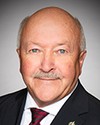Good day, Mr. Chair, Vice-Chair and committee members.
Let me begin by introducing myself. My name is Nicholas Robinson and I am the Director General of Civil Aviation at Transport Canada, responsible for aviation safety.
I am joined here today by my colleague David Turnbull, who is the Director of National Aircraft Certification at Transport Canada.
We are pleased to be here today to support this study related to aircraft certification.
Mr. Chair, let me start off by saying that Canada has one of the safest civil aviation systems in the world. We have achieved this by an unwavering commitment to safety and as a result of an exceptional level of expertise and technical experience that allows for us to make evidence-based safety decisions in this very highly complex, continuously evolving environment.
The certification of an aircraft involves careful examination of the proposed design to verify that the aircraft complies with airworthiness standards and regulations, in short, all the things we expect an aircraft to have to make it safe to fly in Canada.
In the case of a Canadian company manufacturing an aircraft or an aeronautical product such as an engine, for instance, Transport Canada is deemed the certifying authority. That means that state authorities globally look to Canada to ensure the product meets the high safety standards that we set.
This process is aligned with the recommended practice that the International Civil Aviation Organization, commonly referred to as ICAO, has set out in annex 8 of their convention, whereby states do not perform the same in-depth determination of compliance that the state of design has already completed. Instead, states may accept the original certification or use it as the basis for validating the certification.
The certification of an aerospace product is not done overnight. From the application date to the approval, the overall process takes years. Transport Canada works closely with the manufacturer during that period.
In examining past projects we can expect that the testing and analysis phase takes approximately two or more years to complete.
As an example, Transport Canada's certification of the A220 aircraft, formerly known as the Bombardier C Series 300 or 100, took well over 150,000 person-hours to complete over multiple years.
When it comes to products that are not Canadian made, Transport Canada's role consists of validating the certification decisions made by the state of design—the home country of the manufacturer. This ensures that the aircraft or product is safe for use in Canada and complies with our Canadian regulations and our own expectations.
Much like in the case when Canada is certifying a product, we are looking at another major certifying authority, such as Europe's, which is commonly referred to as EASA, the U.S. FAA, or Brazil's ANAC, to lead in the review. In the case of the Boeing 737 Max, the U.S. is the state of design of this aircraft. This means that the Federal Aviation Administration, the FAA, is the certifying authority, and we and other states are validating that certification.
Now, I would like to speak more specifically to the two tragic accidents that took place involving the Boeing 737 Max aircraft.
First and foremost, Mr. Chair, our thoughts continue to go out to the victims and the families of those who have been impacted by the Lion Air and Ethiopian Airlines accidents. Canada is working hard so that other families don't have to suffer through a similar tragedy such as these.
Transport Canada's actions related to the Boeing 737 Max aircraft were first made in response to the October 2018 Lion Air accident. Following that tragedy, Canada developed and implemented, in strong collaboration with our three Canadian operators that fly the Max, which are Air Canada, Sunwing and WestJet, enhanced training requirements for pilots, which exceeded the standards implemented by the American AD and other countries.
These standards were intended to address the runaway trim stabilizer condition that has been identified as a contributing factor in the Lion Air accident and discussed widely in media reports. This was on top of the actions the U.S. undertook as the state of design, and Canada was the only country to put these additional measures in place.
Following the Ethiopian Airlines accident that occurred on March 10, 2019, Transport Canada officials immediately began to assess the risks and the need for additional actions beyond those already taken globally, as well as those taken independently in Canada. Upon receiving and analyzing new satellite data, the department made the determination to close Canadian airspace to the aircraft, the Boeing 737 Max, commencing on March 13, 2019. We received that new data that same morning.
This action demonstrates that Canada makes evidence-based decisions and that we do not hesitate to take action when safety issues are identified. Transport Canada is continuing its independent review and validation of the Boeing 737 Max changes while we continue to work extensively with the state of design and civil aviation authorities in Europe and Brazil and across the globe to realize a possible global return to service of this aircraft. To that end, Canada is taking a leadership role with international authorities to address all factors necessary to achieve a safe return to service. The scope of our review and our concerns have been communicated to the FAA, and Transport Canada officials continue to seek information and assurance on these points.
There are three key areas of concern for Transport Canada that are broader than the maneuvering characteristics augmentation system, commonly referred to as MCAS, which has been commonly reported. These are acceptable levels of pilot workload, the flight control system or architecture for the aircraft, and a minimum training requirement for crew members to operate this aircraft safely.
Until our questions and concerns are satisfactorily addressed, Transport Canada will not lift the airspace restriction on this aircraft.
Additionally, Canada joined the FAA, the National Aeronautics and Space Administration, or NASA, and other civil airworthiness authorities in conducting a comprehensive technical review of the Boeing 737 MAX flight control system. On October 11, 2019, the FAA published the Joint Authorities Technical Review's independent report of the certification process of the aircraft, which includes recommendations brought forward by the review committee.
Our transportation experts continue to work tirelessly on the review of this aircraft, and I am proud of the leadership they have taken to date. Mr. Chair, allow me to assure you and the committee that Transport Canada remains steadfast in its commitment that the Boeing 737 Max will not be permitted to fly in Canada until all concerns have been addressed by the manufacturer and the FAA, and that adequate safety measures for flight crews are in place.
I trust that the foregoing information will serve to shed some light on the aircraft certification process at large as well as on Transport Canada's involvement in the ongoing Boeing 737 Max review. We look forward today to addressing additional questions the committee may have on either subject.
Thank you.




